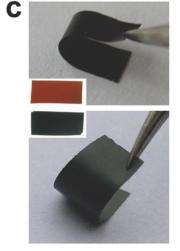New antibacterial material for bandages, food packaging, shoes

A new form of paper with the built-in ability to fight disease-causing bacteria could have applications that range from anti-bacterial bandages to food packaging that keeps food fresher longer to shoes that ward off foot odor. A report about the new material, which consists of the thinnest possible sheets of carbon, appears in ACS Nano.
Chunhai Fan, Qing Huang, and colleagues explained that scientists in the United Kingdom first discovered the material, known as graphene, in 2004. Since then, the race has been on to find commercial and industrial uses for graphene. Scientists have tried to use graphene in solar cells, computer chips, and sensors. Fan and Huang decided to see how graphene affects living cells.
So they made sheets of paper from graphene oxide, and then tried to grow bacteria and human cells on top. Bacteria were unable to grow on the paper, and it had little adverse effect on human cells. "Given the superior antibacterial effect of graphene oxide and the fact that it can be mass-produced and easily processed to make freestanding and flexible paper with low-cost, we expect this new carbon nanomaterial may find important environmental and clinical applications," the reports states.
More information: "Graphene-Based Antibacterial Paper", ACS Nano.
Provided by American Chemical Society


















